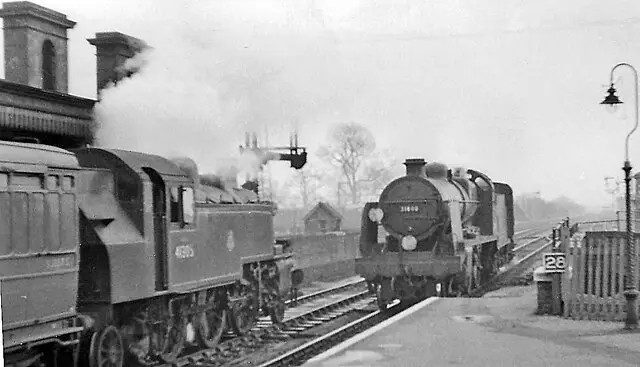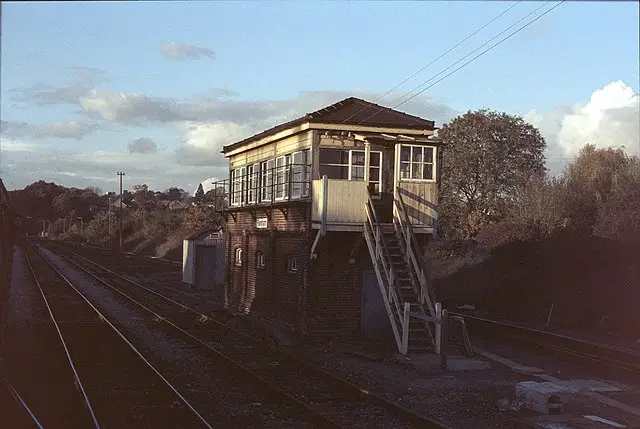Introduction
George Walter Fiddes was born in London in 1863, the son of a house painter. He began his career as a railway employee in his twenties, starting as a porter in London before progressing to a signalman at Fareham. In about 1908, he transferred to the signal box at Hardington Marsh, probably due to health concerns, and continued in this role until his death in 1917.
Childhood
George Walter Fiddes, the seventh child of John and Eliza Fiddes, was born in London on 11 February 1863.[1] He and two of his sisters were baptised at Holy Trinity, Brompton, on 6 May 1866. At that time, the family lived at 30 Queens Gardens, and George’s father was a house painter.[2]
By the age of 17, George was a labourer, and by January 1883, he was a painter living at 139 Marlborough Road, Chelsea.
Marriage
On 20 January 1883, George married Eliza Ann Culpin at St Simon’s, Chelsea. Known as “Annie”, she was the daughter of Richard Culpin of Spalding, a former mariner who had retired from the sea to work as a gardener.[3]
London residences
In April 1891, George and his family lived at 21 Miles Street, Lambeth. In 1896, they lived at 9 William Street, Clapham; in 1899, they lived at 37 Portslade Road, Clapham.[4]
Children
George and Annie had four children: Walter, born on 7 August 1885; Daisy, born about 1887; Ernest, born on 29 May 1891; and another child whose name is unknown.[5]
In the early 1890s, George and Annie suffered immense grief as their children succumbed to disease and death. In April 1891, Walter was a patient at St Thomas Hospital, and he died three years later, aged 9. Daisy died in 1893, aged six, and the unknown child also died.[6] Ernest was the only child to reach adulthood.
Interestingly, the 1901 census recorded a one-year-old “nurse child,” Ernest Fraser, as part of George and Annie’s household, suggesting that Annie sought an outlet for her maternal instincts.
Start of railway employment
By April 1901, George was working as a railway porter.
Fareham
In about 1900, George and his family moved to Fareham, where they lived in Fontley Road. This move marked the beginning of George’s career as a railway signalman.
However, during this time, he may have begun exhibiting symptoms of poor health, which prompted the railway company to transfer him to a signal box with lighter duties.
Hardington
By 1908, George and his family had moved to Hardington, where they lived in one of the railway cottages.[7]
Letter to the Parish Council
In December 1913, George wrote a letter to the Parish Council complaining about the poor state of the stiles and gateways leading from Hardington Marsh to Hardington.[8] The letter suggests that George often used the footpaths to walk to the village.
Death
George died at Hardington Marsh on 8 January 1917 from asthma and heart disease at the age of 53.[9]
Annie’s later life
George and Annie’s only surviving child, Ernest, became a farm labourer. After George’s death, Ernest moved to Pendomer, where he worked for Austin Chick. Annie went with him.
Annie died in 1938, aged 80, probably at Odcombe, where Ernest lived in September 1939.
References
[1] Baptism register of Holy Trinity, Brompton.
[2] Baptism register of Holy Trinity, Brompton.
[3] When she married, Annie gave her father’s occupation as a market gardener, but the 1881 and 1891 census recorded his occupation as a gardener.
[4] Voters’ lists. The New Road School admission register refers to 6 William Street, too.
[5] The 1911 census states that Eliza Ann had given birth to four children, of whom only one was still alive. The births of only three children were registered.
[6] The 1911 census.
[7] Hardington voters’ lists.
[8] Western Chronicle, 12 December 1913, p.7.
[9] Death certificate, which misstates George’s age as 55.



